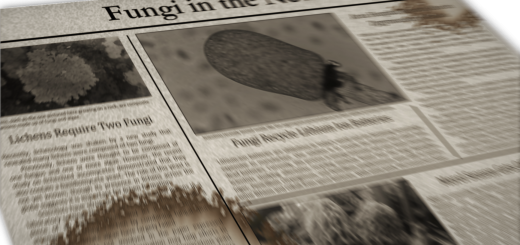#087: Gymnosporangium juniperi-virginianae, Cedar-Apple Rust [Archived]
Note: This is an archived post. You can read the current version of this post here.
Unlike most fungal rusts, Cedar-Apple Rust produces large fruiting bodies during one stage in its life cycle. These structures are probably the strangest-looking fruiting bodies found in North America.
Gymnosporangium juniperi-virginianae (Cedar-Apple Rust) is a member of the order Pucciniales. These obligate plant pathogenic organisms are commonly known as rusts (FFF#130). Many rusts have complex life cycles and produce multiple types of spores. A number of rusts are economically important, such as Coffee Rust (Hemilia vastatrix, FFF#049) and Black Stem Rust of wheat (Puccinia graminis). Rusts are often heteroecious, which means they require two hosts to complete their life cycle. Cedar-Apple Rust, as its name implies, is a heteroecious rust that infects Eastern Red Cedar trees and apple trees at different points in its life cycle.
G. juniperi-virginianae spends the winter in the branches of Eastern Red Cedar (Juniperus virginiana). Cedar-Apple Rust infects branches of those trees and causes the formation of galls. Galls are abnormal growths that prevent the fungus from spreading. In this case, they are brownish, roughly spherical, lumpy, pitted, and up to 3cm in diameter. In the spring, they produce rather large “telial spore horns.” In Cedar-Apple Rust, the spore horns are bright orange, conical, gelatinous, and up to 4cm long. After spring rains, the spore horns soak up water and emerge from the gall. The resulting fruiting bodies look something like a cross between an octopus and a tribble. Spore horns are designed to dry out and rehydrate eight to ten times over the season. Dried spore horns are tough and look like brownish spikes on the outside of the gall.
Fungal hyphae in the gall produce two-celled spores called “teliospores” on the spore horns. Each cell in the teliospore contains two haploid (one of each chromosome) nuclei. While still on the spore horn, each cell in the teliospore germinates to form a basidium (a fungal cell specialized for sexual reproduction). In the basidium, the spore’s two nuclei fuse to form a temporary diploid (two copies of each chromosome) nucleus, which then goes through meiosis. The end result is the production of four haploid spores known as basidiospores. These spores are dispersed by the wind.
To continue on to the next phase in its life cycle, the basidiospore must land on the leaf or fruit of an apple or crabapple tree (Malus sp.). There, the spore germinates and infects the leaf, causing a yellow or orange spot. After a week or two, the hyphae within this spot produce small, orange pustules – known as “spermatogonia” or “pycnia” – on the upper surface of the leaf. These pustules produce spores called either “spermatia” or “pycnidia.” The surfaces of the spermatogonia are covered in a sticky liquid that attracts insects, which carry the spermatia from one spermatogonium to another. At this point, both the spermatia and the infective hyphae within the leaves contain only haploid nuclei. The spermatia function a lot like pollen in plants. When one spermatium is carried to a compatible spermatogonium, it germinates and fertilizes the spermatogonium. Now, the hyphae within the leaf are dikaryotic (they contain two different nuclei that remain separate).
A month or two later, the fungus produces structures on the bottom of the leaf known as aecia. Aecia are small lesions that start out orange and oozing but become brown and stringy. They form the fourth and final type of spore produced by Cedar-Apple Rust: the aeciospore. Aeciospores are dikaryotic and are dispersed by the wind. When aeciospores land on a branch of an Eastern Red Cedar tree, they germinate, infect the branch, and form a gall. This completes the life cycle of Cedar-Apple Rust.
G. juniperi-virginianae can be an economically important plant pathogen. If the infection is severe, apple trees can be defoliated and fruit can deformed, which can result in loss of income for farmers. It can also damage Eastern Red Cedar trees, but this damage does not impact anyone economically. Cedar-Apple Rust is fairly easy to treat. There are fungicides which prevent basidiospores from infecting apple leaves. However, Cedar-Apple Rust can be easily managed without using chemicals. You can remove galls from nearby Eastern Red Cedar trees or cut down those trees to break the disease cycle. There are also varieties of apple that are resistant to Cedar-Apple Rust. With these strategies, apple orchards may develop limited infections that do not damage apple trees or their fruit. The only spores that can infect apple trees are the basidiospores produced by galls on juniper trees. Therefore, there is no risk of the infection spreading from one apple tree to another. Similarly, the only spores that can infect juniper trees are the aeciospores produced on apple trees.
G. juniperi-virginianae is placed in the phylum Basidiomycota, class Pucciniomycetes, order Pucciniales, and family Pucciniaceae. There are a few closely related species that can infect both Eastern Red Cedar and apples, but these have smaller spore horns and broader host ranges. G. globosum is known as Cedar-Hawthorn Rust can infect apples, pears, quince, and serviceberry. G. clavipes is known as Cedar-Quince Rust and can infect those hosts listed above as well as other species in the rose family, flowering quince, mountain-ash, chokeberry, photinia, and cotoneaster.
See Further:
http://botit.botany.wisc.edu/toms_fungi/may99.html
http://www.fs.fed.us/wildflowers/plant-of-the-week/gymnosporangium_juniperi-virginianae.shtml
http://nysipm.cornell.edu/factsheets/treefruit/diseases/car/car.asp
http://www.mushroomexpert.com/gymnosporangium_juniperi-virginianae.html
http://en.wikipedia.org/wiki/Gymnosporangium_juniperi-virginianae








![#011: Characteristics of Kingdom Fungi [Archived]](https://www.fungusfactfriday.com/wp-content/themes/hueman/assets/front/img/thumb-small-empty.png)

1 Response
[…] can read more about rust fungi by visiting the webpages listed below or by reading FFF#087 (Cedar-Apple Rust) or FFF#049 (Coffee […]